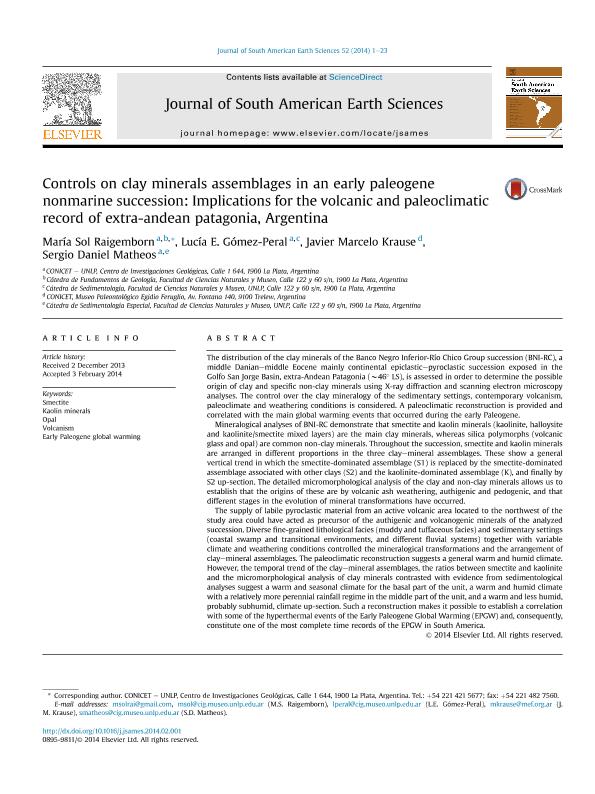Artículo
Controls on clay minerals assemblages in an early paleogene nonmarine succession: Implications for the volcanic and paleoclimatic record of extra-andean patagonia, Argentina
Fecha de publicación:
02/2014
Editorial:
Pergamon-Elsevier Science Ltd
Revista:
Journal of South American Earth Sciences
ISSN:
0895-9811
Idioma:
Inglés
Tipo de recurso:
Artículo publicado
Clasificación temática:
Resumen
The distribution of the clay minerals of the Banco Negro Inferior-Río Chico Group succession (BNI-RC), a middle Danian–middle Eocene mainly continental epiclastic–pyroclastic succession exposed in the Golfo San Jorge Basin, extra-Andean Patagonia (∼46° LS), is assessed in order to determine the possible origin of clay and specific non-clay minerals using X-ray diffraction and scanning electron microscopy analyses. The control over the clay mineralogy of the sedimentary settings, contemporary volcanism, paleoclimate and weathering conditions is considered. A paleoclimatic reconstruction is provided and correlated with the main global warming events that occurred during the early Paleogene. Mineralogical analyses of BNI-RC demonstrate that smectite and kaolin minerals (kaolinite, halloysite and kaolinite/smectite mixed layers) are the main clay minerals, whereas silica polymorphs (volcanic glass and opal) are common non-clay minerals. Throughout the succession, smectite and kaolin minerals are arranged in different proportions in the three clay–mineral assemblages. These show a general vertical trend in which the smectite-dominated assemblage (S1) is replaced by the smectite-dominated assemblage associated with other clays (S2) and the kaolinite-dominated assemblage (K), and finally by S2 up-section. The detailed micromorphological analysis of the clay and non-clay minerals allows us to establish that the origins of these are by volcanic ash weathering, authigenic and pedogenic, and that different stages in the evolution of mineral transformations have occurred. The supply of labile pyroclastic material from an active volcanic area located to the northwest of the study area could have acted as precursor of the authigenic and volcanogenic minerals of the analyzed succession. Diverse fine-grained lithological facies (muddy and tuffaceous facies) and sedimentary settings (coastal swamp and transitional environments, and different fluvial systems) together with variable climate and weathering conditions controlled the mineralogical transformations and the arrangement of clay–mineral assemblages. The paleoclimatic reconstruction suggests a general warm and humid climate. However, the temporal trend of the clay–mineral assemblages, the ratios between smectite and kaolinite and the micromorphological analysis of clay minerals contrasted with evidence from sedimentological analyses suggest a warm and seasonal climate for the basal part of the unit, a warm and humid climate with a relatively more perennial rainfall regime in the middle part of the unit, and a warm and less humid, probably subhumid, climate up-section. Such a reconstruction makes it possible to establish a correlation with some of the hyperthermal events of the Early Paleogene Global Warming (EPGW) and, consequently, constitute one of the most complete time records of the EPGW in South America.
Palabras clave:
Smectite
,
Kaolin Minerals
,
Opal
,
Volcanism
,
Early Paleogene Global Warming
Archivos asociados
Licencia
Identificadores
Colecciones
Articulos(CIG)
Articulos de CENTRO DE INVEST.GEOLOGICAS (I)
Articulos de CENTRO DE INVEST.GEOLOGICAS (I)
Citación
Raigemborn, María Sol; Gómez Peral, Lucia; Krause, Javier Marcelo; Matheos, Sergio Daniel; Controls on clay minerals assemblages in an early paleogene nonmarine succession: Implications for the volcanic and paleoclimatic record of extra-andean patagonia, Argentina; Pergamon-Elsevier Science Ltd; Journal of South American Earth Sciences; 52; 2-2014; 1-23
Compartir
Altmétricas




